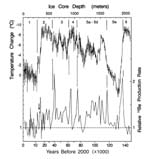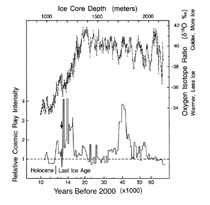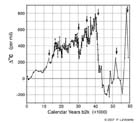|
Problem 11-a:
Geminga is too old to be a candidate for a 41 kyrs b2k supernova.
Their suggestion that the alleged supernova be identified with
Geminga is also problematic. The Geminga neutron star is estimated
to lie about 500 (+200, -100) light years from the Sun, which
is about twice as far as Firestone, et al. suggest for their
supernova scenario. Also their suggestion that Geminga's progenitor
star was as close as 200 light years from the Sun when it exploded
is also very unlikely. Observations of Geminga's proper motion
indicate that it is moving transverse to us at the rate of about
0.4 light years per millennium. Hence if it were to be receding
from us at a similar speed, it would have been only 17 light
years closer at the time of Firestone's proposed supernova. Furthermore
the supernova that gave birth to the Geminga pulsar is conventionally
believed to have occurred 350,000 years ago, almost nine times
longer ago than Firestone, et al. need for their scenario.
Problem 11-b: North Polar Spur remnant is too old
to be a candidate for a 75 kyrs b2k explosion. Others such as C. P. Sonett have postulated a somewhat
older date for a supernova occurring close to the Sun, suggesting
that it occurred 75,000 years ago, instead of 41,000 years ago.
He chose his date in order to explain the large beryllium-10
peaks evident in the polar ice record at 41 and 60 kyrs b2k (Sonett,
1992). He identifies the source of the supernova with the 2 million
year old North Polar Spur remnant, citing a paper by Davelaar,
et al. to justify a younger date for the explosion. However,
Davelaar and his associates were led to assign the remnant the
relatively young age of 75,000 years because of its soft X-ray
emission. But, as mentioned in my dissertation, other researchers
have interpreted this X-ray emission as being due to recent cosmic
ray reheating of a relatively old NPR remnant shell. So the notion
that the NPS remnant is that young is a rather difficult position
to defend.
The value of apriori reasoning.
Like Sonett, Firestone and West were encouraged to propose their
supernova theory to explain the presence of beryllium-10 peaks
that were already evident in the polar ice record. By comparison,
the superwave theory was proposed before Raisbeck, et al. had
published their high resolution Be-10 data showing these peaks.
Like the C-14 data, the Be-10 confirmed a prior prediction made
in 1983 that evidence of recurrent cosmic ray superwave episodes
should be found in Earth's beryllium-10 record. This success
should not be attributed just to good luck, but to the fact that
a good case had already been made for the superwave theory based
on astronomical data available at that time.
Problem 12: The 41 kyrs b2k rise in beryllium-10 concentration
does not have a supernova signature.
Figures 2 and 3 chart the atmospheric beryllium-10 production
rate as normalized to the Holocene average as seen in the Vostok
and Byrd Station, Antarctic ice core records, data taken from
publications by Raisbeck, et al. and Beer, et al. If the Earth
had been exposed 41,000 years ago to a gamma ray flash from a
nearby supernova, we would expect to see a sharp beryllium-10
spike at this date, the whole event being registered within several
centimeters of ice comparable to the atmospheric residence time
for Be-10 ions which is on the order of a few years. Instead,
we see that beryllium-10 flux began to climb several thousand
years prior to this date reaching a peak around 40 to 41 kyrs
b2k with the entire event spanning 6,000 to 7,000 years. Certainly,
this does not match the signature of a gamma ray flash. But a
superwave cosmic ray volley could last that long. Interestingly,
this major superwave peak correlates with the disappearance of
Neanderthal Man (LaViolette, 1990).
 (click to enlarge) (click to enlarge)
Figure 2. Upper profile: Ambient air temperature at Vostok,
Antarctica as indicated by ice deuterium content (from Jouzel,
1987). Lower Profile: Beryllium-10 production rate at the
Vostok ice core site normalized to the Holocene average. This
profile was produced by adjusting the Be-10 concentration data
of Raisbeck, et al. (1987, 1992)
for changes in ice accumulation rate according to the ice accumulation
rate model described in LaViolette (2005c).
Arrow indicates the 12.9 kyrs y2k boundary.
|
|
 (click to enlarge) (click to enlarge)
Figure 3. Upper profile: Ice core oxygen isotope ratio at
Byrd Station, Antarctica, an indicator of ambient temperature
(courtesy of W. Dansgaard). Lower profile: Beryllium-10 production
rate at Byrd Station normalized to the Holocene average. This
profile was produced by adjusting the Be-10 concentration data
of Beer, et al. (1987) for
changes in ice accumulation rate according to the ice accumulation
rate model described in LaViolette (2005c).
|
Problem 13: The 40 kyrs b2k
radiocarbon anomaly does not have a supernova signature.
The supernova theory encounters the same difficulty in explaining
the radiocarbon anomaly that occurred around that time. Figure
4, adapted from Hughen (2004),
charts the change in atmospheric C-14 concentration over the
past 60,000 years as measured at Cariaco Basin. It shows that
radiocarbon concentration began to rise 4000 years prior to the
proposed 41 kyrs b2k Geminga supernova date, reaching a peak
around 40 kyrs b2k.* Certainly, such a long-term increase does
not match the signature of a supernova gamma ray flash whose
secondary particle barrage would have lasted on the order of
years, not millennia. Also note that there are a total of six
major events in which C-14 significantly increased (marked by
arrows). Besides the large peak at 40 kyrs b2k and the smaller
peaks at 35 and 13 kyrs b2k, we see peaks also at 30, 52, and
59 kyrs b2k. The two earlier events precede the time of the proposed
supernova date. It is very difficult to explain C-14 anomalies
repeating so frequently with a phenomenon as rare as nearby supernova
explosions. However, Galactic superwaves could arrive frequently
enough to explain these findings. The other possibility is that
many of the peaks may be due to a rise in solar flare activity,
but as described earlier, such increases are likely associated
with the arrival of superwaves and their ability to fill the
solar system with cometary dust.
 (click to enlarge) (click to enlarge)
Figure 4. Radiocarbon abundance excess relative
to trend line in a Carioca Basin sediment core (after Hughen,
et al., 2004).
Problem 14:
Supernova explosions don't occur frequently enough to explain
so many Be-10 peaks. Multiple cosmic ray events are also
evident in the Vostok Be-10 record. At least a dozen Be-10 production
rate spikes are present there, eight of which precede Firestone
and West's proposed 41,000 year b2k supernova date. Moreover,
both beryllium-10 records show a set of cosmic ray peaks falling
at the beginning of the last deglaciation and spanning the period
of the megafaunal mass extinction. At one event every million
years, supernovae just don't occur frequently enough to explain
this kind of recurrence. More specifically, an energetic type-II
supernova would occur even more rarely. So they cannot adequately
account for the multiple events recorded in the geologic record.
Superwaves, however, can account for this degree of frequency.
Since there is a considerable amount of evidence that
points to the past passage of a superwave cosmic ray volley at
the end of the last ice age, there is no need to seriously consider
a supernova explosion as a cause either of the beryllium-10 peaks
or of the megafaunal extinction. Why invent another explanation
when we already have a good, well documented explanation already
in hand? This is not to say that nearby supernova do not produce
hazardous effects on our planet from time to time. But, without
hard astronomical evidence of a nearby supernova shell expanding
at the alleged speed of thousands of kilometers per second, it
is difficult to make the case. Moreover, as is explained in section
6 below, the superwave theory is able to account for many aspects
of the Pleistocene extinction that are difficult to account for
on the basis of a cometary explosion. Problem 15: Insufficient
dust to induce elevated solar flare activity. In their book, Firestone, West, and Warwick-Smith
(2006, p. 246) propose that
"the debris wave of the supernova could have seriously disrupted
the sun, causing a prolonged period of flare eruptions."
In reference to this they cite the lunar rock evidence of Zook
et al. which indicates that the Sun was particularly active during
the deglacial period. However, the amount of supernova debris
that would have entered the solar system would have been at least
a billion times too small to have had this kind of effect on
the Sun. Let us suppose that half of the material in the remnant
shell was in the form of comets and the other half in the form
of dust and gas that could be more easily drawn in and accreted
by the Sun. Based on our earlier calculations (Problem
2), this amounts to a total of about 10 ng/cm2. Distributing this over a 44 light year thick
remnant shell (passing the Sun for 6000 years at a speed of 2200
km/s), we get a debris density of only 10-27 g/cm3, or
about 10 million times smaller than the current interplanetary
dust density. So there would have been a negligible effect compared
with the effects of the current dust influx to the Sun. The superwave
theory, by comparison, proposes cometary dust concentrations
over 100 million times higher than this, and mass influx rates
over 1000 times higher (LaViolette, 1983a, 1985).
(Read further for more problems)
________________
* Although the rise in C-14 concentration between 45 and
40 kyrs b2k (100% increase) was far larger than the rise at 12.9
kyrs b2k (7% increase), the instigating cosmic ray intensity
in each case may have been comparable. The reason that C-14 rose
to such high levels for the earlier event is that the event lasted
longer allowing a greater quantity of radiocarbon to accumulate
in the atmosphere. In each instance C-14 rose on the order of
3 percentage points per century.
|
 (click to enlarge)
(click to enlarge)
